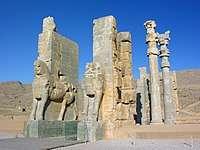Justanids
| Justanids جستانیان | |||||||||
|---|---|---|---|---|---|---|---|---|---|
| 791–11th-century | |||||||||
| Capital | Rudbar | ||||||||
| Common languages |
Persian Deylami | ||||||||
| Religion |
Zoroastrianism (791–805) Zaydi Islam (805–11th-century) | ||||||||
| Government | Monarchy | ||||||||
| King | |||||||||
• 791–805 | Justan I (first) | ||||||||
• 972–1004 | Khusrau Shah (last) | ||||||||
| Historical era | Middle Ages | ||||||||
• Established | 791 | ||||||||
• Ismaili conquest | 11th-century | ||||||||
| |||||||||
The Justanids or Jostanids (Persian: جستانیان) were the rulers of a part of Daylam (the mountainous district of Gilan[1]) from 791 to the late 11th-century.[2]
History
The Justanids appear as "Kings of Daylam" at the end of the 8th century. Their centre was in the Rudbar of Alamut, running into the valley of the Shahrood. Two centuries later, this had become the main centre of the historical Nizari Ismailis or Assassins (Hashshashin) as they are known in the west. They appear in Islamic history as part of what Vladimir Minorsky has called "the Iranian intermezzo".[3] This is where indigenous Daylamite and Kurdish principalities take power in north west Persia after two to three hundred years of Arab rule. The Daylamite upsurge eventually culminated into the Buyid dynasty.
After Marzuban ibn Justan converted to Islam in 805, the ancient family of Justan's became connected to the Zaydi Alids of the Daylam region. The Justanids adopted the Zaydi form of Shi'ism. In the 10th century, they became eclipsed by the Daylamite dynasty of Sallarids in Tarom (modern Iranian province of Zanjan). Nevertheless, the Justanids were tied into marriage with the Sallarids and preserved their seat Rudbar in the highlands of Daylam. They also became allies with the Buyids. In the 11th century, they might have recognized the Suzerainty of the Ghaznavids. With the influx of the Seljuqs, they recognized the Suzerainty of the Seljuqs. But shortly after, they fade away from history.
Justanid rulers
- Justan I (791–805)
- Marzuban of Daylam (805–855)
- Justan II (855–856)
- Vahsudan of Daylam (856–865)
- Khurshid of Daylam (865)
- Justan III (865-919)
- Ali of Daylam (919)
- Khusrau Firuz (919)
- Siyahchashm (919–928)
- Justan IV (928–947)
- Manadhar (947–972)
- Khusrau Shah (972–1004)
Family tree
| Justan I r. 791–805 | |||||||||||||||||||||||||||||||||||||||||||||
| Marzuban r. 805–855 | |||||||||||||||||||||||||||||||||||||||||||||
| Justan II r. 855–856 | |||||||||||||||||||||||||||||||||||||||||||||
| Vahsudan r. 856–865 | |||||||||||||||||||||||||||||||||||||||||||||
| Justan III r. 865-919 | Khusrau Firuz r. 919 | Ali r. 919 | Khurshid r. 865 | ||||||||||||||||||||||||||||||||||||||||||
| Unknown | Kharasuya | Siyahchashm r. 919–928 | |||||||||||||||||||||||||||||||||||||||||||
| Unnamed prince | |||||||||||||||||||||||||||||||||||||||||||||
| Justan IV r. 928–947 | |||||||||||||||||||||||||||||||||||||||||||||
| Manadhar r. 947–972 | |||||||||||||||||||||||||||||||||||||||||||||
| Khusrau Shah r. 972–1004 | Fuladh | Unnamed princess | |||||||||||||||||||||||||||||||||||||||||||
| Ibn Fuladh | |||||||||||||||||||||||||||||||||||||||||||||
References
- ↑ http://www.iranicaonline.org/articles/jostanids
- ↑ Madelung 1975, p. 224.
- ↑ Minorsky, Vladimir (1953). Studies in Caucasian History. New York: Taylor’s Foreign Press.
Sources
- Donohue, John J. (2003). The Buwayhid Dynasty in Iraq 334h., 945 to 403h., 1012: Shaping Institutions for the Future. ISBN 9789004128606. Retrieved 13 February 2014.
- Madelung, W. (1992). Religious and ethnic movements in medieval Islam. ISBN 0860783103. Retrieved 13 February 2014.
- Madelung, W. (1975). "The Minor Dynasties of Northern Iran". In Frye, R. N. The Cambridge History of Iran, Volume 4: From the Arab Invasion to the Saljuqs. Cambridge: Cambridge University Press. pp. 198–249. ISBN 978-0-521-20093-6.
- Clifford Edmund Bosworth, The New Islamic Dynasties: A Chronological and Genealogical Manual, Columbia University, 1996.
- Minorsky, Vladimir, Studies in Caucasian History. New York: Taylor’s Foreign Press, 1953.
- Pezeshk, Manouchehr (2009). "JOSTANIDS". Encyclopaedia Iranica, Vol. XV, Fasc. 1. pp. 44–46.
